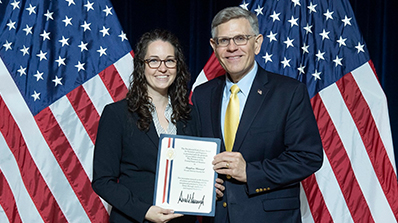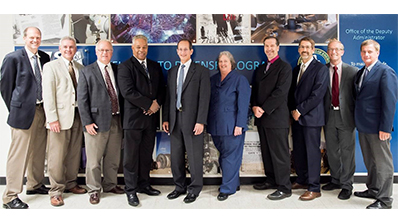Following four years of service as the Nevada National Security Site (NNSS) representative for the National Nuclear Security Administration (NNSA) Defense Programs Science Council, Distinguished Scientist Howard Bender is passing the torch to Principal Scientist Marylesa Howard.
Created to explore science, technology and engineering opportunities for the NNSA, the Defense Programs Science Council is comprised of one representative from each NNSA production site and laboratory. Together, the team pursues science and technology best practices throughout the enterprise, analyzes stockpile planning and hedge strategies, and supports the development of the NNSA Stockpile Stewardship and Management Plan.
Bender was appointed to the role in 2016 as the first-ever NNSS representative.
“I’d like to think of the science council as more of a scientific and technical working group that advises the head of Defense Programs,” said Bender. “The group is tasked with looking at significant current and future challenges to the weapons program. Each of us has our own part in the weapons program, and we would tackle those as a think tank. Each of us brought our own perspective and knowledge base to the issue we were asked to look at.”
The council also supports NNSA’s nonproliferation and counterintelligence missions, and it collaborates with the Department of Defense and other federal agencies that have a role in NNSA’s Defense Programs activities.
“I see the group as helping to transform the complex and stockpile stewardship in the future,” said Bender. “I think it’s going to be instrumental in architecture for future stockpile efforts and other national security matters revolving around the weapons program.”

The council, which meets monthly in addition to twice a year at NNSA headquarters in Washington, D.C., was re-established in 2010 to investigate and explore cross-cutting science, technology and engineering issues and opportunities that have an impact across the NNSA.
“I think it’s one of the most phenomenal working groups I’ve been a part of in my career,” said Bender, who worked with NNSA and NNSS leadership to recommend Howard as his successor. “Someone else needs a chance at this.”
Howard, a signal processing and applied mathematics scientist, comes to the NNSA Defense Programs Science Council after receiving the United States government’s highest honor for scientists who demonstrate exceptional leadership in independent research careers – the Presidential Early Career Award for Scientists and Engineers (PECASE) – in July 2019.
“I would like to bring access and visibility to NNSS resources and capabilities, as well as some of our less-visible talents,” said Howard. “If the science council has a need that could utilize our resources and knowledge, I would love to connect the dots.”
Having already cultivated a network of peers in the NNSA through her career and PECASE, Howard says she looks forward to continuing to build opportunities throughout the enterprise.
“We have been putting together plans for how our NNSS analysis team can expand our role in future subcritical experimental needs at the labs. I’m really excited to see the doors that open up for our team and the new collaborative relationships we build with the laboratories.”
For more information about Defense Programs, see https://www.energy.gov/nnsa/missions/maintaining-stockpile.

